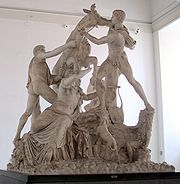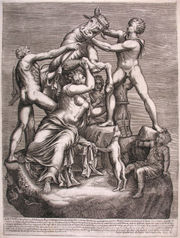
Farnese Bull
Encyclopedia

Apollonius of Tralles
Apollonius of Tralles was a Greek sculptor who flourished in the 2nd century BCE. With his brother Tauriscus, he executed the marble group known as the Farnese Bull, representing Zethus and Amphion tying the revengeful Dirce to the tail of a wild bull....
and his brother Tauriscus
Apollonius of Tralles
Apollonius of Tralles was a Greek sculptor who flourished in the 2nd century BCE. With his brother Tauriscus, he executed the marble group known as the Farnese Bull, representing Zethus and Amphion tying the revengeful Dirce to the tail of a wild bull....
. We know this thanks to the writings of Pliny the Elder
Pliny the Elder
Gaius Plinius Secundus , better known as Pliny the Elder, was a Roman author, naturalist, and natural philosopher, as well as naval and army commander of the early Roman Empire, and personal friend of the emperor Vespasian...
. He tells us it was commissioned at the end of the 2nd century BC and carved from just one whole block of marble. It was imported from Rhodes
Rhodes
Rhodes is an island in Greece, located in the eastern Aegean Sea. It is the largest of the Dodecanese islands in terms of both land area and population, with a population of 117,007, and also the island group's historical capital. Administratively the island forms a separate municipality within...
, as part of the incredible collection of artwork and sculptures owned by Asinius Pollio
Gaius Asinius Pollio (consul 40 BC)
Gaius Asinius Pollio was a Roman soldier, politician, orator, poet, playwright, literary critic and historian, whose lost contemporary history, provided much of the material for the historians Appian and Plutarch...
, a Roman politician who lived during the years between the Republic and the Principate. It is the largest single sculpture ever recovered from antiquity
Ancient history
Ancient history is the study of the written past from the beginning of recorded human history to the Early Middle Ages. The span of recorded history is roughly 5,000 years, with Cuneiform script, the oldest discovered form of coherent writing, from the protoliterate period around the 30th century BC...
.
This colossal marble
Marble
Marble is a metamorphic rock composed of recrystallized carbonate minerals, most commonly calcite or dolomite.Geologists use the term "marble" to refer to metamorphosed limestone; however stonemasons use the term more broadly to encompass unmetamorphosed limestone.Marble is commonly used for...
sculptural group represents the myth of Dirce
Dirce
Dirce was the wife of Lycus in Greek mythology, and aunt to Antiope whom Zeus impregnated. Antiope fled in shame to King Epopeus of Sicyon, but was brought back by Lycus through force, giving birth to the twins Amphion and Zethus on the way...
. She was tied to a wild bull by the sons of Antiope
Antiope (mother of Amphion)
In Greek mythology, Antiope was the name of the daughter of the Boeotian river god Asopus, according to Homer; in later sources she is called the daughter of the "nocturnal" king Nycteus of Thebes or, in the Cypria, of Lycurgus, but for Homer her site is purely Boeotian. Her beauty attracted Zeus,...
, Amphion and Zethus
Amphion and Zethus
Amphion and Zethus , in ancient Greek mythology, were the twin sons of Zeus by Antiope. They are important characters in one of the two founding myths of the city of Thebes, because they constructed the city's walls....
, who wanted to punish her for the ill-treatment inflicted on their mother, first wife of Lykos
Lycus (brother of Nycteus)
In Greek Mythology, Lycus was a ruler of the ancient city of Ancient Thebes . His rule was preceded by the regency of Nycteus, and he was succeeded by the twins Amphion and Zethus.-Genealogy:...
, King of Thebes
Thebes, Greece
Thebes is a city in Greece, situated to the north of the Cithaeron range, which divides Boeotia from Attica, and on the southern edge of the Boeotian plain. It played an important role in Greek myth, as the site of the stories of Cadmus, Oedipus, Dionysus and others...
.

Baths of Caracalla
The Baths of Caracalla in Rome, Italy were Roman public baths, or thermae, built in Rome between AD 212 and 216, during the reign of the Emperor Caracalla.- History :...
in Rome
Rome
Rome is the capital of Italy and the country's largest and most populated city and comune, with over 2.7 million residents in . The city is located in the central-western portion of the Italian Peninsula, on the Tiber River within the Lazio region of Italy.Rome's history spans two and a half...
during excavations commissioned by Pope Paul III
Pope Paul III
Pope Paul III , born Alessandro Farnese, was Pope of the Roman Catholic Church from 1534 to his death in 1549. He came to the papal throne in an era following the sack of Rome in 1527 and rife with uncertainties in the Catholic Church following the Protestant Reformation...
in the hope of finding ancient sculptures to adorn Palazzo Farnese, the Farnese Roman residence. Along with the rest of the Farnese antiquities, it is now located at the Museo Archeologico Nazionale Napoli in Naples
Naples
Naples is a city in Southern Italy, situated on the country's west coast by the Gulf of Naples. Lying between two notable volcanic regions, Mount Vesuvius and the Phlegraean Fields, it is the capital of the region of Campania and of the province of Naples...
.

